|
We all know what the CPU is - it's the "brains", the "engine" if you will of the computer, also known as the "Central Processing Unit", and sometimes it has a companion to help with floating point mathmatics - the "Math Co-PRocessor". I'm limiting this page to the Pentium/K6 era, because that's where my interest in vintage PC's tends to end. So I'm going to match the CPUS, to their socket, and then write a little bit about each one....just so you can get the drift. And then we will do the same with the Math Co-Processors and what they are compatible with. I will try and use my own pictures when I can, but if I can't, I'll use whatever I can search for from the internet.
PROCESSORS
| PICTURE
| CONNECTION PICTURE
| NAME & SPECS
| DESCRIPTION/COMMENTS
|

| 
| Intel 8088
| The original Intel 8088 was a cost-reduced version of the Intel 8086 released in 1978. This was the chip used in the original IBM Personal Computer 5150 in 1981, as well as the PC XT (1983), PC Jr (1983), Tandy 1000/A/EX/SX, and Compaq Portable. It runs 16-bit code but only has a 8-bit external bus for memory and expansion, thusly why early PC clones had only 8-bit expansion slots and slow RAM. It sits in a 40 pin double-wide DIP Socket and is also compatible with the NEC V20 CPU (also listed below).
|

| 
| Intel 8086
| The intel 8086 is the fully 16-bit version of the 8088, released in 1978. The Intel 8086 was used in the original Seattle Computer PRoducts prototype Tim Patterson created QDOS for - the program that Microsoft bought for around $15K in 1980 after bluffing to IBM That they had an operating system for their new PC. IBM chose to go with the cheaper part on the PC, but some other manufacturers leverage the 8086, such as Compaq and their original Deskpro (1984), and IBM also used it in their PS/2 Model 25 and 30 released in 1987. It is compatible with the NEC V30.
|

| 
| NEC V20
| The NEC V20 CPU is a microcontroller chip that is pin and code compatible with Intel's 8088 microprocessor. IT offers up to a 40% speed boost in processing power compared to a INtel 8088 at the same clock speed, and thusly, was a very popular upgrade in early PCs for gamers and people who need just that little push over the edge in horsepower to get their work done faster.
|
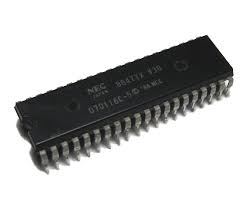
| 
| NEC V30
| The NEC V30 CPU is pin and code compatible with the Intel 8086 and was also a popular replacement/surrogate for that chip with a 40%-ish speed increase in some systems. The NEC V30 even came standard in some machines, such as it's creator's own highly influential portable, the NEC UltraLite released in 1988.
|
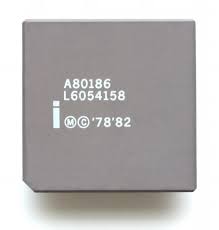
| 
| Intel 80186
| THe Intel 80186 was a microcontroller chip often used in PC Peripherals and add-ins but also found it's use in a few systems, most notably Tandys TRS-80 2000 "MS-DOS Compatible" system from 1982. There were a rare few clone boards with it as well. It does offer a few of the more advanced instructions of the 80286 but on a chip that's closer in execution to an 8086. It never really caught on though because as it was starting to show up a little more the 286 IBM PC AT came out and set the new standard.
|


|  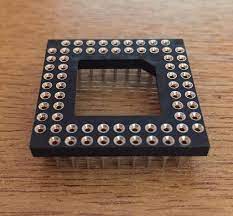
| Intel 80286
| The Intel 80286, or "286" (Two-Eighty Six) is a 16-bit CPU with two distinct operating modes: a 8088 compatible "Real Mode" which it was used in most of the time in the PCs it was sold as a part of, and then a faster, more capable "Protected Mode" that allowed the chip to access up to 16 Megabytes of RAM and allowed for Preemtive Multitasking. However, the 286 had some problems being able to "hot swap" between these modes which lead to it not being a popular choice either outside the "Fast XT" or specialized "Unix Workstation" realms. It also was rumored Bill Gates called the 286 "Braindead" because of this issue. However, as the 286 continued on through it's lifecycle, programmers figured out ways to switch modes without resetting the CPU, or resetting the CPU without resetting the O/S. The 286 came in PLCC, PGA, and Carrier arrangements depending on make/speed/model.
|

| 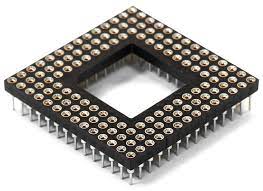
| Intel 80386 DX
| The intel "386" (Three-Eighty Six) was the first 32-bit x86 CPU in Intel's x86 product line. It was released in 1985 and premiered in the Compaq Deskpro 386 in 1986. The DX was the full fledged, 32-bit version that had a 32-bit memory address bus, as well as the ability to use a 32-bit expansion bus. However, it was still somewhat "castrated" by the IBM standards of the day (16-bit ISA Slots mainley), so it would not see it's true potential until much later.
|
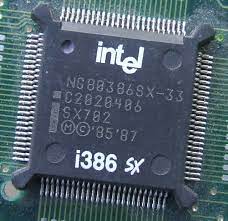
| SOLDERED TO MOTHERBOARD
| Intel 80386 SX
| The 386 SX was a 32-bit code capable, but 16-bit external CPU. There are rumors that this CPU was designed to allow motherboard manufacturers to reuse old 286 motherboards with minimal/no redesign. The chip was commonly used on cost-reduced consumer, and regular end-user enterprise class workstations of the time, focused on saving money, rather than speed. They were a little popular for awhile there until the 486 line came out with such a huge plethora of options.
|
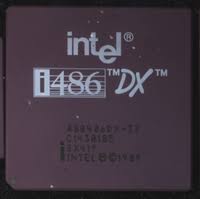
| 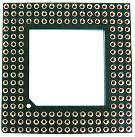
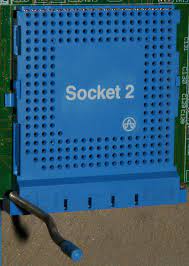
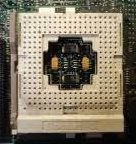
| Intel 80486 DX
| Released in 1989, the Intel 486 (Four Eighty Six), was seemingly a huge deal at the time. It made several massive improvements that have carried over to today's modern 64-bit powerhouse CPUs found in today's PCS. These include an on-board maths co-processor, an on-board (Level 1, 8k) Cache, and some pipelining capabilities. The 486 DX started off as a major powerhouse CPU for true power users and did not really catch on till about 1992 when teh clock doubled DX2 series came out. These early 486 CPU's - including the DX/SX/DX2 - that used the 168 pin PGA (Pin Grid Array) Socket are compatible with all three major 486 socket types which includes (but is not limited to): Socket 1 (bare PGA LIF Socket), Socket 2 (5VDC ZIF Socket), and Socket 3 (3/3.5/5VDC ZIF Socket). The intel 80486 really spawned a huge line of different CPUs and was the first time the consumer was really aware that there was more than one version of a particular CPU en-masse, hence why I posted up all the 486 variants here because this is really when that started to matter. The DX was originally the top-of-the-line CPU until 1992 when the DX2 series came out.
|

| SOLDERED TO MOTHERBOARD
| Intel 80486 DX SL
| Released in 1991, the 486 DX SL is a 3.3v version of the 486 intended for laptop computers to reduce power consumption and enhance battery life. These CPUS include some advanced Power Management (APM) Feature not available on the first as well, such as the ability to throttle down to a lower speed when on battery. The trend would continue on through the DX4 series. These CPUS were almost always soldered to the motherboard of the laptop computer they were installed into and not user upgradable. Performance is comparative to the 5VDC non-SL part.
|
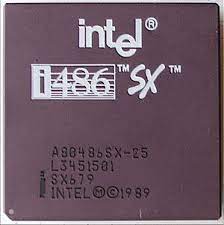
| 


| Intel 80486 SX
| The 486 SX was a version of the 486 "without" a math co-processor. The reason I say "without" in quotes, is because it's rumored that these were either CPUs where the on-board 487 failed the test, or Intel was aritficially laser-disabling the 487 on-board the cPU chips to meet a quota for a lower cost CPU. All rumors aside though, the 486 SX was no slouch either, selling well at the lower end of the consumer market, expecially after the DX2 came long. It was one of the more popular CPUs found in Packard Bell machines at the time. These early 486 CPU's - including the DX/SX/DX2 - that used the 168 pin PGA (Pin Grid Array) Socket are compatible with all three major 486 socket types which includes (but is not limited to): Socket 1 (bare PGA LIF Socket), Socket 2 (5VDC ZIF Socket), and Socket 3 (3/3.5/5VDC ZIF Socket). The 486 SX however has a bit of a spotty reputation as Intel started to perform some nefarious business practices with this particular product. You see, the 486 SX was often, at least early on, a 486 DX with a Math Co-PRocessor that failed the QC test, and was laser-cut out. To get the FPU functionality the 486 DX had, you had to buy a 487 SX Math Co-PRocessor, which is said to be nothing more than a re-branded 486 DX CPU in the same clock speed, that disabled the pre-existing 486 SX if it's soldered in, or replaces it in a regular CPU socket.
|

| 


| Intel 80486 DX2
| When most people think "486", this is what they think of, the heyday for the 486 was 1992-1994, and the king of the hill for (most of) that time was the Intel 486 DX2-66. The 486 DX2 was a "clock doubled" CPU, meaning the CPU ran at twice the speed of the system bus - which would be 20 (DX2-40), 25 (DX2-50), or 33 (DX2-66) MHz. This allowed for faster processing and this was the premier CPU to run DOOM on when it came out (so huge deal there). The 486 DX2 is a frickin' legend and still a very good CPU today for retro DOS and early Windows gaming as well as even doing some serious stuff with hit. My NanTan 9200 currently runs this CPU. These early 486 CPU's - including the DX/SX/DX2 - that used the 168 pin PGA (Pin Grid Array) Socket are compatible with all three major 486 socket types which includes (but is not limited to): Socket 1 (bare PGA LIF Socket), Socket 2 (5VDC ZIF Socket), and Socket 3 (3/3.5/5VDC ZIF Socket). The 486 DX2, especially the 66MHz model (DX2-66), has gone down as one of the most esteemed and famous 486 CPU chips in history, in part because it came out around the time the massive success DOOM came out (one of the first really good First Person Shooter games, which runs it perfectly), and it also was one of the first CPUs out when the Internet was starting to catch on with regular people. It also was the last 5vdc part offered by Intel.
|

| SOLDERED TO MOTHERBOARD
| Intel 80486 DX2 SL
| The Intel 486 DX2 SL was the same deal as with the regular 486 DX and DX2. It's a SL enhanced version of the 486 DX2 intended for portable computers, which around that time the 486 was starting to become the dominant CPU. Some machines that used these included the Samsung SENs Series, the NEC Versa E and V series, AT&T Globalyst 200 and Safari 3151, and quite a few Toshiba high end models. These CPUS are great for a MS-DOS laptop and it seems, at least in the context of the NEC Versa 40EC and V50 I had, run on a level between that of a regular DX2 and a DX4. Unfortunatley, you cannot upgrade these as they are soldered to the motherboard usually.
|

| 


| Intel 80486 SX2
| Along with a DX2, there was a very very rare SX2 variant meant for cost reduction. It seems people were getting a little more leniant in their spending on computers as the 90's went on so I can't say much for it. Same deal as the DX2, just no math co-processor on board (or it was permanantley disabled). Either way, the SX2 is an interesting and kind of rare chip now that offers no real benefit outside of $$ for it's rarity. These early 486 CPU's - including the DX/SX/DX2 - that used the 168 pin PGA (Pin Grid Array) Socket are compatible with all three major 486 socket types which includes (but is not limited to): Socket 1 (bare PGA LIF Socket), Socket 2 (5VDC ZIF Socket), and Socket 3 (3/3.5/5VDC ZIF Socket). The SX2 is, as I said, quite a rare piece of history and more interesting to CPU collectors than it is to people who actually use their vintage computers for stuff. Probably a part of the reason why was because people were becoming hep to the fact that there was no floating point unit on the SX series CPUs, and it seems to help Windows (3.1) run better, and indeed does help Windows 95 and higher run better. So not really a top pick, but an interesting one.
|
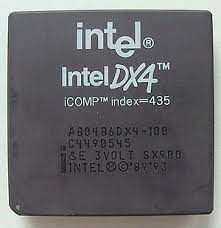
| 
| Intel 80486 DX4
| In 1993, Intel released the 486 DX4, a clock tripled version of the 486 with 16KB of L2 Cache (double the original), and later versions (&EW designation after the Intel A080486DX4 marking on the chip) had WriteBack Cache schemes like the Pentium processor had. These were one mean little 486 and could give some lower-grade Pentium systems a run for their money, with my two most famous systems being the NanTan 9200 and the IBM PC-330 100DX4 T/C:6571-W5K model, which are just unshakable beasts with this chip. The DX4 is my personal favorite for a retro system, and what I currently run in almost all of my vintage 486 systems,including the extremely rare IBM Blue Lightning Variant I run in my Compaq. The 486 DX4 was a 3.3v CPU, and as such was not compatible with the older Socket 1 and Socket 2 CPU Sockets that could run a regular 5VDC Intel CPU. Typically these were found in a "Socket 3" motherboard with a VLB or PCI Bus and typically are considered a part of the "Pentium Killers" because they could, indeed, with the right amount of RAM, and right software configuration, give an early Pentium CPU a real run for it's money in processing power. The DX4 was most popualr in the 75MHz and 100MHz clock speeds, though AMD made one that went up to 120MHz that's extremely rare.
|
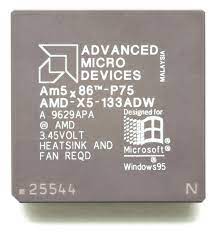
| 
| AMD Am5x86 133 PR75
| In 1995, AMD took the 486 up to the next level with a 133MHz WriteBack capable chip, that also took being overclocked to 160MHz really, really well (a BIOSTAR MB8433UUD Motherboard with a Am5x86 in it overclocked to 160Mhz was a magical machine to behold - my ex-roomie gave me one of these and it was my first Linux and Windows 2000 box). These are a bit hard to get now because so many retro-gamers seem to want them, which is a tad annoying. But they are a great system.
|
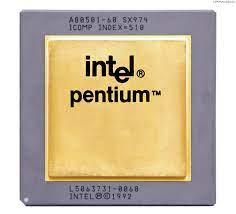
| 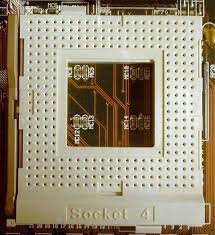
| Intel Pentium 60/66
| Released in 1993, the original "Socket 4" Pentium failed to catch on due to thermal issues and a infamous Floating Point bug that kept them from really taking off for the first two years of their existence as a released product. The Pentium 60/66 are more interesting now as collectors pieces than they are as actual gaming rigs. But what does make these interesting is some of these early Socket 4 Pentium machines had VESA Local Bus, and another article I read said these were basically 2 486 Cores, (so basically, a Dual Core 486, LOL) which was a big part of their crappy power consumption and overheating problems (an issue Intel would revisit with their Pentium-D CPU in 2006 - what was that? A Dual Core Pentium 4?).
|
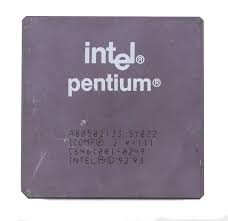
| 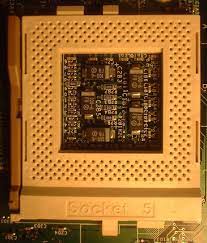 
| Intel Pentium
| Released in 1995, the "Classic Pentium" chip is one of the most famous, legendary Intel CPU ever released. Over the rest of the 1990's, these were THE processor to have (or one of it's many faster/newer offspring), but even in 2000 an original Pentium was no slouch either. Later, around 1997 or so, Intel added their MMX (MultiMedia Extention) technology to them making them a favorite for people interested in doing things like video and playing back DVDs on their computer with a MPEG decoder card. These things were so popular Weird Al made a friggin song about em', lol. They came in clock speeds of 75, 90, 100, 133, 166, 200, and 233MHZ, with some of the later versions (133-233MHz) coming with "MMX" MultiMedia Extention Technology inside. Which improved performance of multimedia applications such as DVD playback and mpeg movies. These CPU's initially used the "Socket 5" design for the 166MHz and older parts, but were also compatible with the "Super Socket 7" Socket 7 PGA ZIF used later on. The reason Socket 7 was referred to as "Super" was becuase it literally survived as a usable main computer up through a part of the Windows XP era at the turn of the century.
|
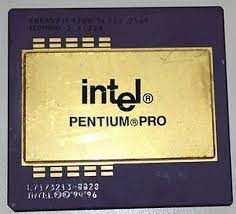
| 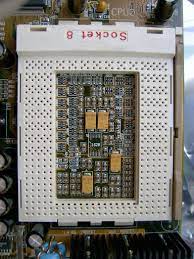
| Intel Pentium Pro
| The true beginning of the 686 architecture was the Pentium Pro, a CPU aimed at high powered workstations and PC-based servers in 1996. The Pentium Pro is a rare beast these days indeed, but in it's day it was a massive corporate monster, hosting webpages, acting as fileshares and print servers, databases for the 1990's version of big data. Handling multiple subnets as a Domain Controller or DHCP server. But what people did not know was that a used Pentium Pro was also a great machine that could hold it's own along side a Pentium II or Pentium III just fine. I even had one for awhile, I ran The Sims and Robot Arena 2 on it. The Pentium Pro was an interesting CPU in that it kind of merged the eras of the regular Pentium Socket 5/7 systems together with tthe later 686 machines like the Pentium III/III/4 together. It performs well enough that the Pentium Pro was a very usable system past the turn of the century, but it also was kind of forgotten/neglected because it was a system more familiar with Network Administrators and corporate power users than it was to people who had a desktop computer at home at the time. Sort of one of those diamonds in the rough for awhile However, today, the command a high price due to their rarity and high level of capabilities. And right here we are scratching the veyr edge of what I myself consider vintage because I could see a Pentium Pro being quite a capable and powerful system still using BSD or Linux these days, enough to do something modern and useful.
|
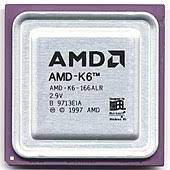
| 
| AMD K6
| The original AMD K6 was a Pentium II "Equivalent" product launched in 1998 by CPU maker AMD, and designed to fit into the pre-existing Socket 7 ZIF Socket used by most late-model Intel Pentium processors. These CPU's ran at 66MHz Front Side bus Speed with a clock speed of 166, 200, 233, 266, and 300MHz. They really put the "Super" into Super Socket 7, keeping a lot of these machines in commission well into the middle of the 2000's as they were decent enough to run Windows XP, and rather capable systems in general.
|
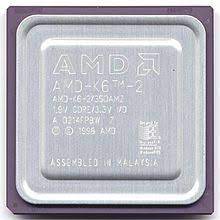
| 
| AMD K6 II
| The AMD K6 II came out in 1998 just a little after the K6, and featured additional instructions known as 3DNOW!, making these also a great CPU for Windows 9x "Retro" machines. Just like the K6, they could fit into a standard Super Socket 7 motherboard and could perform at levels that gave a Pentium II a run for it's money in some cases. These continued to keep these machines going for a lot longer than expected. They came in clock speeds of 200 to 570MHz and were very fast. As the name imlies, these were designed with late Windows 9x era gaming in mind most likely, and they were more cost effective than the current intel product of the time.
|
MATH CO-PROCESSORS
| PICTURE
| CONNECTION PICTURE
| NAME & ASSOCIATED CPU(S)
| DESCRIPTION/COMMENTS
|
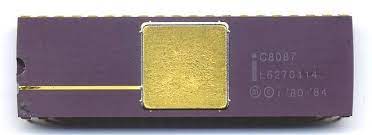
|
| Intel 8087
i8088/8086
| THe intel 8087 was a Math Co-Processor intended for the Intel 8086/8088, and was seldom seen on early PC's because most people did not have a massive need for it. The #1 purpose of Math Co-Processors in the early days was for Computer Aided Design (CAD), Medical Sciences, NASA, and other things where large calculations needed to be made, and made quickly, and very precisely. That said, it's not an entirely useless addition to a PC/XT System as some games do support it such as Microsoft Flight Simulator and the original Sim City release.
|
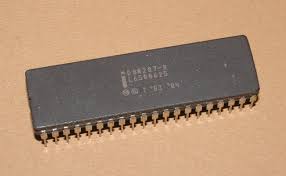
|
| Intel 80287
i80286
| The Intel 80287 was the Math Co-PRocessor intended for the Intel 286. It basically did all the same things the 8087 did for the 8086/8088, just with some additional features added to work with the 286 and give a benefit there. Oddly, some 386 motherboards included a 287 socket to save money, however, the 387 would come out later as well to negate all that.
|
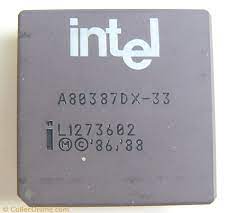
|
| Intel 80387 DX
i80386 DX
| This is the math co-processor that matches up to the PGA socket Intel 80386 DX CPU chips. It needs to match the bus speed of the 386 chip (or be faster than it) to work correctly. It must also be a DX chip if there is a DX CPU and vice versa.
|

|
| Intel 80387 SX
i80386 SX
| This is the math-coprocessor that matches up with the surface mount and PLCC Intel 80386 SX CPUs, and it's also used with any upgrade chips (ie Evergreen REV2486 or MakeIt486) that attach to that socket.
|
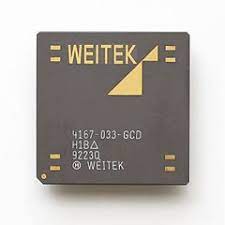
|
| Weitek Math CoProcessor 1167
i80386 DX
|
|
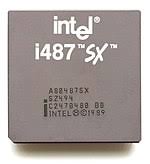
|
| Intel 487 Math Co-Processor
i80486 DX
| Really more a "scam" than anything, the intel 80487 was really just an Intel 80486 DX CPU that mounted over/disabled the Intel 80486 SX chip on the motherboard, or just outright replaced it.
|
Upgrade CPUs that Swap Generations
One thing about these old computers was that they were extremely expensive in the early days, some costing as much as a brand new VW Rabbit GTI. As such, it was of interest to the consumer or business that used the technology to make that particular machine last as long as possible.

An Orchard 286 upgrade card for a i8088 based system. This was the earliest form of cross-generation PC CPU Upgrades
Early on they used ISA cards like above, which would add a CPU and some of the required circuitry to make it work on an 8088 or 8086 based computer to make it a quasi-AT (or what we like to call a XT/286 system). What these basically did was used the ISA bus to circumvent the pre-exiting i8088 CPU, and add some performance boosts (whatever they could with tne rinky dink, clock coupled ISA bus safely), and get a machine that would at least be able to run newer software, though the performance was not exactly the same as a comparable system of hte same speed with all the 286 AT acoutrimonts.
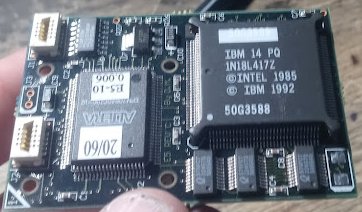 
An Evergreen RevTo486 Upgrade Chip, this is the exact same one that's in my Compaq Deskpro 386s/20 computer - it's a IBM 486 "Blue Lightning" chip that brings the computer into low-end 486 DX2 territory, and runs at 75MHz
The next trend through the 286/386 era, was the addition of these "snap-on" upgrades that could make your 286 or 386 a 386 or 486 class machine. Some of how these worked was that when the 386SX came out, intel intentionally designed it to be compatible with older 286 motherboard designs so manufacturers could just install the 386SX chip on an already pre-designed 286 motherboard. This in turn lead to these newer 486 upgrade being compatible with some 286 systems and 386 SX systems - such as the RevTo486 I have listed above from my Compaq. Again, similar deal to the 8088-to-286 card from Orchid above, you got all the benefits of a faster CPU, but some "bottlenecking" in the form of a slower bus speed, slower memory speed, older graphics controller, older BIOS calls for the hard disks - all that fun stuff.
  
Above: The 486 era brought us multitudes of CPUs of the same generation, and the one ahead of it, compatible with the same three sockets shown above.
The computer manufacturers and hardware makers started to get more invested in the idea of "upgradability" by the early 1990's when the 486 was king of the hill. A big part of this was a lot of complaints from customers about how their systems were "outdated as soon as they left the showroom floor". Things were advancing so fast, all of the time, that the minute a machine was starting to get popular, a newer, faster widget already replaced it. The 486 era was RIFE with this stuff: EISA, VESA Local Bus, PCI, 486 DX/SX/SL/DX2/BLX2/BLX3/DX4/Am5x86/Pentium Overdrive 83 MHz....the rise from regular 256K VGA to fast PCI and VLB cards with 1-4MB of RAM, all the way to early 3D Acceleration like the old 3DFX VooDoo Cards (which became NVIDIA). I mean, a sub-$100 486 from 1995 was unrecognizable from the spartan beige brick you'd buy in 1989 for $3000.
But this set the precedent for all CPUs going forward. And that's how we have done it ever since, the 486 brought us the "upgradable CPU" actually sanctioned by the manufacturers. Versus buying some sketchy "upgrade kit" from your local computer shop that's slower and not as stable as the full gamut of what the sanctioned CPU upgrades could provide. And some of these upgrades could overshadow some of the next generation. A 486 DX4-100 can really hold it's own with a Pentium 90. An AMD K6-II 570MHz is up there with some Celerons and slower PEntium III systems. The CPU, however, is not the only part of what makes a vintage system "Fast" - it also comes down to the Motherboard.
How important is the CPU in a vintage computer
Honestly, it's still very important, it's just the reason FOR it's importance is what has changed.
Back in the day, the importance regarded what BUSINESS software you would run generally, and how big the files you were working with were, or how fast a connection you needed, or how complex the software was that you were running. But what also mattered was how important was how to AFFORD that stuff. If everyonec ould afford one, they would have bought the fastest computer on the market, but since this was a costly investment, as expensive as some CARS were at the time - seriously, some early 1991 laptops cost as much as a base-model 1991 Ford Ranger Pickup Truck!
But today, it's still important to consider the software, but since 90% of us are not using these old machines for productivity, but rather FUN (ie gaming usually), then it's more important to consider what eras of gaming you are using when it comes to CPU, and what those era's had in general, what was required as a minimum, and how far forward you can go before the majority of your software collection fails to be functional.
The first importance is what ERA of computing are you using the most. People who basically just want to relive their days in the early 1980's might be fine with a 8088 PC XT machine or a 286-based computer. Golden Age of DOS Gaming fans might want something beefier like a 386 DX-40 or a nice and spritely 486 DX2 or DX4 system, while those seeking out mostly Windows 9x bliss might want to go as high as a Pentium II or even Pentium 4.
8088/8086/80186 era Stuff - Most of the games and software form this era was CGA/EGA/Text Mode stuff that fit on a single floppy disk, and was akin to most arcade games of the time. Basically, simple little time wasters designed for a brief jaunt between spreadsheet and word document, or a way to get your kids to "understand computers" evne though you hardly understood them yourself. A LOT of this software was completley "un-throttled" - meaning the code in the program did not detect CPU speed and throttle it down if it caused an overflow or ran too fast in some cases. This means a lot of this very early stuff was a case for Turbo Switches on later generations (286-486), and sometimes, it's really worth having an 8088 in your fold. A Tandy 1000 is my 8088/XT class system of choice. Games of this era included ZZT, Microsoft Adventure, Astrododge, Pitfall! (NOT the David Crane Atari 2600 classic), Cabal, Street FIghting Man, Ford Simulators 1 & 2, Memory Match, Reader Rabbit, Funnels & Buckets, and a lot of those "type in yourself" BASIC games found in computer magazines of the time.
286/early 386 era - This was the beginning of the "Golden age of DOS Gaming", when the games started getting really good. Most of these games COULD work on an 8088 or 8086, but unless it was a particularly fast one (ie 10MHz), it would probably be painful to unplayable on such a system. So enter the PC AT and 386 era machines. For business back then people started doing pie charts, bar graphs, and sophisticated spreadsheets and presentation due to the advances in EGA graphics and larger hard disk sizes. These computers were also among the oldest to get sound cards installed toward teh end of the 80's, and some of the earliest "Multimedia" PCs.
386 & early 486 Era - This is where the CPU started getting a little more important, I think largely in part due to the move toward 32-bit DPMIs in some DOS Programs, and the beginning of Microsoft Windows being a successful GUI on top of DOS (remember, Windows was not considered a full blown Operating System until Windows 95). At this point, certain games and applicaitons would not run, or at least, not run well on an 8086/8088 CPU machine (ie Ultima VI: The False Prophet on my Tandy 1000SX and Tandy 1000A), and might run a little sluggish on a 286 (ie Monkey Island 2's ridiculous wait times on my GEM 286). It also seems some of this importance was the result of a chip shortage in the industry at the time that drove up RAM prices a good bit (remember how it affected Nintendo and other's at the time outside the PC industry), so you had to get more muscle out of the CPU than the RAM. This had a side-effect though of people thinking the faster their chip is, the faster the computer is, which is generally true, but only to a certian extent. A lot more of it was bragging rights, hence why a lot of people were all about "Get a 386" or "get a 486" as the industry was starting to go mainstream at the time due to a growth of PC users in the work sector, and some people choosing to work from home on their own PCs. This was also why we saw....
486 & Early Pentiums - The 486 era was like "adolescence" for this platform. It's where the PC went from being something run by a nerd in his bedroom to surf BBSes, pirate games, and finish spreadsheets for college or work, to a mainstream device used for personal entertainment via the internet. At this point, the CPU became even moreso important because of features of both CPUs that differentiate performance. Earlier 486/586 era programs, like DOOM, tend to be more slanted toward a 486 for performance, while later programs were all about the Pentium chip. Increasingly, more companies started to port their programs to Microsoft Windows (3.1x mostly), usually through either a upgrade program, something like Sierra did where they made a new custom interpreter for their DOS programs (ie SIERRAW.EXE), or "made the move to Windows" and started offering their programs as Windows only programs (most productivity and programs having to do with the internet). And that's another important piece, because in 1989, TIm Berner's Lee gave us HTML, the Web Browser (NCSA Mosaic), and thusly, the Internet as we know it (or World Wide Web as it was called..."WWW"). During this time, the Web was largely CPU Agnostic and not that important - it was one of the few things you could participate in from DOS still via browser like LYNX. But it had not caught on yet, and was mostly STEM field peeps and College students getting into STEM fields with their own personal passion websites coded in HTML (like this one). However, the role of the CPU for the internet got more important as time went on.
Today's Vintage PC - Putting it All Together - Today's vintage computers - 8088-80486 era we will focus on - the CPU importance is really up to you, because there are so many factors involved and so many different, unique, and otherwise, "strange" use-cases today. It's even important to at least know SOME regarding emulation so you can have the most accurate experience with a DOS emulator or PC x86 Emulator of your choice.
People like me who run real hardware, all depend on what era of retro-computing we prefer. For me, I need at least TWO systems for the best experience - a pokey old 8088 system for all the really early stuff (with a V20 CPU at least under the hood) ~ which would be my Tandy 1000, and a ripping 486 DX4 machine for "everything else" because even a super-fast DX4-100 can handle some rather old software quite comfortably. Technically my "tweener" is a 486, and my full blown vintage box is an 8088.
The CPU is a part of this because most systems from faster 15MHz 286 machines on up cannot accuratley slow down enough, even with a turbo button, to run DOS programs from the early-mid 1980's reliability at the right speed, and certain aesthetics I prefer in such a system of the era anyway, are not exactly the most comfortable on a 486 system full-time. So I use the Tandy with TGA, with a nice medium dot-pitch EGA display, and it gets me a pretty wide swath on software compatibility - from 1981 till about 1989 or so. Some of the olde rprograms I run that are speed dependant (without patches or modifications at least) include: Ultima II: Revenge of the Enchantress, early ASCII DOS and BASIC games (Maxit, Depthcharge, Apple Panic!), while others are a bit sluggish by default, for example, I run Kings Quest (the 1986 AGI version, not the 1984 original) at FULL walking speed comfortably on the Tandy 1000, but on a 486, I can't run it past medium or the next thing I know in the blink of an eye I'm in a lake drowning with the Witch seeking to eat me and the game over music playing. Due to the CPU limitations, I can only run LYNX as my web browser, no e-mai, and am largely reliant on mTCP suite for most internet/network related things.
Meanwhile, the 486 DX4 at oldest can get to stuff from MAYBE 1985, or 1986 at the oldest, where it becomes almost too fast. Things that are a little speed dependant, such as Ultima VI, run VERY Comfortably (too fast if I use the mouse) on such a system, where the boost in speed becomes a benefit rather than a detractor. It might not be fully accurate to running on an actual 1990 system, but it IS accurate to running on a blazing fast 1995 era 486. I can also go as high as Windows 2000 PRofessional X86 with this setup, and run comfortably most of the time, getting a real nightmare speed penalty runnining applications I don't think ever were intended to run on a 486, such as Firefox 10 ESR (yes, I run Firefox on a friggin 486 - it's awesome just to know it works). With such a wide swath, my only real upper limits are graphics cards due to the BUS, and RAM Size (64MB max is what my 486 is happy with), I can do a lot still with a 486 PC that I can do with a modern Linux system in a lot of cases. It has me thinking maybe FreeDOS should look at bringing the vintage PC into the 21st century a little bit.
|







